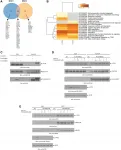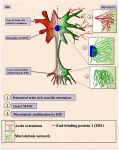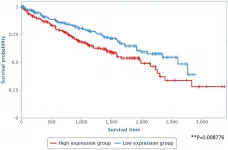(Press-News.org) Sclerosis, Parkinson's Disease, Alzheimer's and epilepsy are but a few of the central nervous system disorders. They are also very difficult to treat, since the brain is protected by the blood-brain barrier.
The blood-brain barrier works as a border wall between the blood and the brain, allowing just certain molecules to enter the brain. And whereas water and oxygen can get through, as can other substances such as alcohol and coffee. But it does block more than 99 percent of potentially neuroprotective compounds from reaching their targets in the brain.
Now, in a study conducted in living, including awake mice, a team of researchers from the University of Copenhagen provides direct insight on how to trick the blood-brain barrier's impermeable walls to allow drug delivery to the brain.
They investigated so-called nanoparticle liposome drug carriers and delivered them past the blood-brain barrier while tracking and monitoring them all the way through the system.
"Before this study, the community had no insight what was happening in the blood-brain barrier in the living brain, and why some nanoparticles crossed and others wouldn't. In this regard, the blood-brain barrier was a 'black-box' where the events between drug administration and detection in the brain remaind obscures. It was even doubted whether nanoparticle entry to the brain was possible at all. With our paper, we now provide a direct proof of nanoparticle entry to the brain and describe why, when, and where it happens," explains Assistant Professor Krzysztof Kucharz from the Department of Neuroscience.
The researchers, aided by colleagues at the Technical University of Denmark and Aalborg University, used two-photon imaging to deconstruct the blood-brain barrier in order to understand how the nanoparticle drug carriers travel past the blood-brain barrier in a living organism.
"We monitored the nanoparticles entry to the brain at each step of the process, providing valuable knowledge for the future drug design. Specifically, we show which vascular segments are the most efficient to target with nanoparticles to allow their entry to the brain. And because we were able to monitor the drug carriers at the level of a single nanoparticles, we now provide a novel platform to develop more efficient and safer therapeutic approaches," says Krzysztof Kucharz.
The study, released in Nature Communications, shows that nanoparticles targeted to the brain are picked up in the capillaries and venules by endothelial cells, which are the cells in the blood-brain barrier that allow or reject access of molecules to our brain tissue.
"Analogically to the mythical Trojan horse they are recognized by endothelium and transported across the blood-brain barrier to the brain. These nanoparticles have a cargo space that can be loaded with various neuroprotective drugs to treat many neurodegenerative diseases. This approach is currently tested in many clinical and preclinical trials in brain cancer, stroke, Alzheimer's and Parkinson's disease. However, the levels of nanoparticle transport into the brain are still low and need to improve to reach clinical significance. Therefore, there is a great need to optimize nanoparticle drug delivery and to do so, it is crucial to understand how nanoparticles interact with the blood-brain barrier. This is where we came into play.", says Krzysztof Kucharz.
The researchers used a two-photon imaging approach to study nanoparticles allowed them to open the blood-brain barrier "black box" and get a full picture of nanoparticles route across the blood-brain barrier. They tagged the particles with fluorescent molecules, which allowed the microscopy of nanocarriers in the living, intact brain at the resolution level of a single nanoparticle.
Now, they could observe how nanoparticles circulate in the bloodstream, how they associate over time to the endothelium, how many are taken up by the endothelium, how many are left behind, what happens to them once inside the blood-brain barrier and where the nanoparticles exit to the brain. Then, they observed that brain vessels handle the nanoparticles differently, allowing or rejecting access of nanoparticles to the brain tissue depending on the vessel type.
"Although the anatomy and function of the endothelium differ between different vessel types, this principal feature of the brain had so far been overlooked in drug delivery studies, and whether or how it impacted drug delivery had been unknown," says Krzysztof Kucharz.
They show that nanoparticles can enter the brain mainly at big vessels, i.e. venules, which are surrounded by so-called perivascular space, and not, as previously believed small and numerous capillaries. The perivascular space surrounds venules making nanoparticles easier to exit the endothelium and progress further into the brain, but it is absent in capillaries.
"Our results challenge the assumed view that capillaries constitute the main locus for nanoparticle transport to the brain. Instead, venules should be targeted for efficient nanoparticle drug delivery to the brain", says Krzysztof Kucharz.
The methodological platform developed by authors may constitute an excellent platform to fine-tune nanoparticle formulations for increased transport to the brain and provide valuable information for the future design of novel drug delivery systems. This will hopefully provide a great leap forward to efficiently treat brain disorders.
INFORMATION:
In 2015, 170 countries worldwide adopted the Paris Agreement, with the goal limiting the average global temperature increase to 1.5°C. Following the agreement, many countries and cities proposed targets for greenhouse gas mitigation. However, the UNEP Emissions Gap Report 2020 shows that, without drastic and strict actions to mitigate the climate crisis, we are still heading for a temperature increase of more than 3°C by the end of the 21st century.
A new study published in the journal Frontiers in Sustainable Cities presents the first global balance sheet of greenhouse gasses (GHGs) emitted by major cities around the world. The aim was to research and monitor the effectiveness of historical GHG reduction ...
A new study published by Wiley early online in CANCER, a peer-reviewed journal of the American Cancer Society, has identified unmet social needs in women with gynecologic cancer that could be addressed to improve care for patients and lessen disparities. For example, identifying patients who reported needing help with reading hospital materials resulted in the use of a cancer care navigator who provided patient education and support, facilitating physician-patient communication and adherence to care recommendations.
The prospective survey-based ...
Oncotarget published "Inhibitory effects of Tomivosertib in acute myeloid leukemia" which reported that the authors evaluated the therapeutic potential of the highly-selective MNK1/2 inhibitor Tomivosertib on AML cells.
Tomivosertib was highly effective at blocking eIF4E phosphorylation on serine 209 in AML cells.
Moreover, combination of Tomivosertib and Venetoclax resulted in synergistic anti-leukemic responses in AML cell lines.
Mass spectrometry studies identified novel putative MNK1/2 interactors, while in parallel studies we demonstrated that MNK2 - RAPTOR - mTOR complexes are not disrupted by Tomivosertib.
Overall, these Oncotarget findings demonstrate that Tomivosertib exhibits potent ...
Oncotarget published "Epigallocatechin-3-gallate modulates Tau Post-translational modifications and cytoskeletal network" which reported that the chemical modulators of Tau PTMs, such as kinase inhibitors and antibody-based therapeutics, have been developed, but natural compounds, as modulators of Tau PTMs are not much explored.
These authors applied biophysical and biochemical techniques like fluorescence kinetics, oligomerization analysis and transmission electron microscopy to investigate the impact of EGCG on Tau glycation in vitro.
EGCG inhibited methyl glyoxal -induced Tau glycation in vitro.
EGCG potently inhibited MG-induced advanced glycation endproducts formation in neuroblastoma cells as well modulated the localization ...
Oncotarget published "A novel E2F1-regulated lncRNA, LAPAS1, is required for S phase progression and cell proliferation" which reported that long non-coding RNAs are major regulators of many cellular processes, including cell cycle progression and cell proliferation.
Inhibition of LAPAS1 expression increases the percentage of S phase cells, and its silencing in synchronized cells delays their progression through S phase.
In agreement with its suggested role in cell cycle progression, prolonged inhibition of LAPAS1 attenuates proliferation of human cancer cells.
Importantly, knockdown of SPNS2 rescues the effect of LAPAS1 silencing on cell cycle ...
Imagine sitting out in the sun, reading a digital screen as thin as paper, but seeing the same image quality as if you were indoors. Thanks to research from Chalmers University of Technology, Sweden, it could soon be a reality. A new type of reflective screen - sometimes described as 'electronic paper' - offers optimal colour display, while using ambient light to keep energy consumption to a minimum.
Traditional digital screens use a backlight to illuminate the text or images displayed upon them. This is fine indoors, but we've all experienced the difficulties of viewing such screens in bright sunshine. Reflective screens, however, attempt to use the ambient light, mimicking the way our eyes ...
Researchers have identified a specialized protein that appears to help prevent tumor cells from entering the bloodstream and spreading to other parts of the body.
"We have discovered that this protein, TRPM7, senses the pressure of fluid flowing in the circulation and stops the cells from spreading through the vascular system," said Kaustav Bera, a Johns Hopkins University PhD candidate in chemical and biomolecular engineering and a lead author of the study, which was done with colleagues at the University of Alberta and Universitat Pompeu Fabra.
"We found that metastatic tumor cells have markedly reduced levels of this sensor protein, and that is why they ...
Men over 60 with low-risk prostate cancer could spend ten years with no active treatment, have a better sex life as a result, yet still be very unlikely to die from the disease, new research has found.
The findings come from two new studies looking at 'active surveillance' of prostate cancer - when the disease is closely monitored but not treated - presented at the European Association of Urology congress, EAU21, today.
The first uses data from Sweden's National Prostate Cancer Register, which has information on virtually every man diagnosed with the disease in that country since 1998 - 23,649 of whom went on active surveillance. ...
Care homes need to be vigilant for outbreaks of COVID-19, even after residents have received two doses of the vaccine, according to new research being presented at the European Congress of Clinical Microbiology & Infectious Diseases (ECCMID) held online this year.
Long-term care facilities, such as care homes with elderly residents with multiple underlying conditions, are at high risk of COVID-19 outbreaks and many vaccination campaigns have initially focused on care home residents and the staff looking after them. An outbreak in a French care home, however, raises questions about how effective the vaccine is in the elderly.
Martin Martinot, of ...
COVID-19 outbreaks in French nursing homes almost certainly started in staff - and none of measures put in place stopped the virus from taking hold, new research being presented at the European Congress of Clinical Microbiology & Infectious Diseases (ECCMID), held online this year, shows.
Residents of long-term care facilities represent a small fraction of the general population but account for a disproportionate number of SARS-CoV-2-related deaths in many countries.
In France, 5,203 outbreaks (of 1 case or more) were reported in nursing homes during the first wave of COVID-19. In the Auvergne-Rhône-Alpes region, there were 651 outbreaks, 3,885 residents had confirmed COVID-19 infection and 1,772 ...



